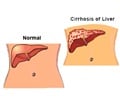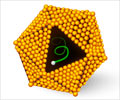- Ala A, Walker AP, Ashkan K, Dooley JS, Schilsky ML (2007). "Wilson's disease". Lancet 369 (9559): 397–408. doi:10.1016/S0140-6736(07)60196-2. PMID 17276780.
About
Other names: Hepatolenticular degeneration, Copper storage disease
Wilson’s disease is a rare inherited systemic disorder of copper metabolism. Copper is a key ingredient in the development of healthy nerves, bones, collagen, and the skin pigment melanin. Normally any excess is excreted through bile — a substance produced in your liver. Though, in this disease, copper initially accumulates in the liver from birth onwards, it may not manifest into visible symptoms till around adolescence. They generally occur between 6-45 years of age, but it is possible they may come on in mid-life.

The most visible sign of ‘Wilson’s Disease’ is the rust colored rings around the edges of the cornea.
When the copper has filled the liver completely it causes inflammation, disease and loss of function of the liver totally and also enters other organs like the eyes, brain and kidneys. The range of problems are, a mild elevation of enzymes to total failure of the liver, weight loss, fatigue, abdominal swelling perhaps by fluid accumulation, loss of appetite, and even jaundice.
If you are very young these symptoms are more acute. After teenage there are neurological symptoms which stand out prominently.
Wilson's disease is a rare disease and affects only 1 in 30,000 of the population. It has equal propensity for men and women in all racial groups.
Wilson’s disease should not be confused with Wilson’s (temperature) syndrome, also called Wilson’s thyroid syndrome or WTS. The syndrome describes as a thyroid-related one that presents with various non-specific thyroid-related symptoms with normal thyroid lab function tests. Some doctors treat it with a thyroid drug called triiodothyronine. However The American Thyroid Association (ATA) does nor believe in its existence as it lacks "well-known and widely-accepted facts" concerning the functions of the thyroid and has raised concerns about the proposed treatments with any drug as this they believe is potentially harmful.









